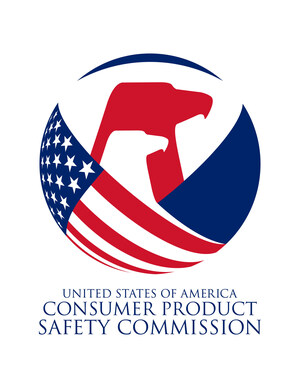WASHINGTON, Aug. 16, 2022 /PRNewswire/ -- As students head back to class this fall, the U.S. Consumer Product Safety Commission (CPSC) is urging parents, teachers, and students to "Put Safety in Your Backpack" this school year. From backpacks to playgrounds, classroom chemistry experiments to college housing, consumers should watch for hidden hazards students encounter daily.
Following these safety tips as students head back to class can help to prevent injuries before they occur:
For elementary and middle school-bound students:
*Backpacks:
Make sure backpacks for students are not too heavy.
From 2019 to 2021, there were an estimated annual average of 1,200 backpack-related injuries to children under 19 years old treated in emergency rooms.
*Playgrounds:
Remove neck or waist drawstrings from sweatshirts and jackets and remove necklaces to prevent strangulation hazards. Check for sharp points or edges on playground equipment. Do not play on slides or other surfaces that are burning hot.
From 2019 to 2021, there were an estimated annual average of 155,900 playground-related injuries to children under the age of 16.
For high school-bound students:
*Classroom Chemistry Experiments:
Minimize the risk of injuries to students from open flames in chemistry experiments.
Parents: Attend back-to-school night or contact the teacher and ask about precautions that will be taken during experiments using fuels and flames.
Schools and teachers: Conduct a hazard analysis and take proper precautions. Consider safer demonstrations, such as a flame test instead of a rainbow experiment. If pouring flammable liquids, use the smallest beakers possible, and keep larger containers out of the classroom. Do not use flasks.
*Bicycles and E-scooters:
Watch CPSC's video on e-scooter safety.
Wear a helmet to help protect your head in falls and collisions. Knee and elbow pads can also help to prevent injury.
Follow all manufacturer directions and check the e-scooter's safety information, such as weight and age limits.
Check for damage before riding e-scooters, ensure that handlebars, brakes, throttle, bell, lights, tires, cables, and frame are in good condition. Damage to the e-scooter can cause loss of control and crashes.
Always test the brakes for how long it takes to stop the e-scooter, and to be prepared for emergency stops. Stopping distance can vary significantly, depending on the scooter.
See and be seen, wear reflective clothing! E-scooters are small, quick and silent, making it difficult for others to spot operators. Expect vehicle drivers and pedestrians not to see you.
Use the bell/horn to alert others and do not make abrupt, unpredictable movements.
Always be present and never allow the e-scooter battery to charge while unattended. Only use the charger that came with the device.
Avoid overcharging. Follow the manufacturer's instructions for proper charging.
For college-bound students:
*Fire Safety:
Check that there are smoke and carbon monoxide alarms in the student's housing and make sure the alarms are working.
CPSC recommends having smoke alarms on every level of a home, inside each bedroom and outside sleeping areas.
Carbon monoxide alarms should be on every level and outside sleeping areas.
Make sure there are two ways out from each room and a clear path to the outside from each exit.
Keep combustibles away from heat sources and do not overload electrical outlets, extension cords and power strips.
Report any dangerous product or a product-related injury on www.SaferProducts.gov.
Related links:
Chemistry Experiments Safety Poster
Chemistry Experiments Checklist
About the U.S. CPSC
The U.S. Consumer Product Safety Commission (CPSC) is charged with protecting the public from unreasonable risk of injury or death associated with the use of thousands of types of consumer products. Deaths, injuries, and property damage from consumer product-related incidents cost the nation more than $1 trillion annually. CPSC's work to ensure the safety of consumer products has contributed to a decline in the rate of injuries associated with consumer products over the past 50 years.
Federal law prohibits any person from selling products subject to a Commission ordered recall or a voluntary recall undertaken in consultation with the CPSC.
For lifesaving information:
- Visit CPSC.gov.
- Sign up to receive our e-mail alerts.
- Follow us on Facebook, Instagram @USCPSC and Twitter @USCPSC.
- Report a dangerous product or a product-related injury on www.SaferProducts.gov.
- Call CPSC's Hotline at 800-638-2772 (TTY 301-595-7054).
- Contact a media specialist.
Release Number: 22-203
SOURCE U.S. Consumer Product Safety Commission

WANT YOUR COMPANY'S NEWS FEATURED ON PRNEWSWIRE.COM?
Newsrooms &
Influencers
Digital Media
Outlets
Journalists
Opted In





Share this article